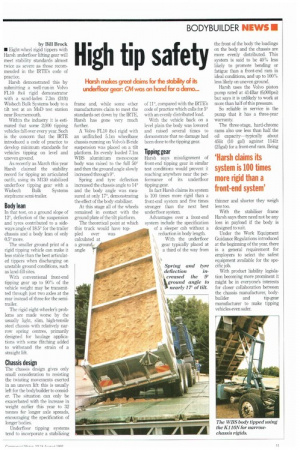High tip safety
Page 13

If you've noticed an error in this article please click here to report it so we can fix it.
Harsh makes great daims for the stability of its underfloor gear al was on hand for a demo-.
by Bill Brock • Eight-wheel rigid tippers with Harsh underfloor lifting gear will meet stability standards almost twice as severe as those recommended in the 1RTE's code of practice.
Harsh demonstrated this by submitting a well-run-in Volvo FLIO 8x4 rigid demonstrator with a sand-laden 7.3m (24ft) Wisbech Bulk Systems body to a tilt test at an MoD test station near Bournemouth.
Within the industry it is estimated that some 2,000 tipping vehicles fall over every year. Such is the concern that the 1RTE introduced a code of practice to develop minimum standards for vehicles tipping on level and uneven ground.
As recently as March this year Harsh claimed the stability record for tipping an articulated outfit, using its M130 stabilized underfloor tipping gear with a Wisbech Bulk Systems stepframe semi-trailer.
Body lean In that test, on a ground slope of 120, deflection of the suspension and tyres contributed to a sideways angle of 18.5' for the trailer chassis and a body lean of only 0.5° more.
The smaller ground print of a rigid tipping vehicle can make it less stable than the best articulated tippers when discharging on unstable ground conditions, such as land-fill sites.
With conventional front-end tipping gear up to 90% of the vehicle weight may be transmitted through just two axles at the rear instead of three for the semitrailer.
The rigid eight-wheeler's problems are made worse by the usually light, slim, high-tensile steel chassis with relatively narrow spring centres, primarily designed for haulage applications with some flitching added to withstand the strain of a straight lift.
Chassis design
The chassis design gives only small consideration to resisting the twisting movements exerted in an uneven lift: this is usually left for the bodybuilder to consider. The situation can only be exacerbated with the increase in weight earlier this year to 32 tonnes for longer axle spreads, encouraging the specification of longer bodies.
Underfloor tipping systems tend to incorporate a stabilizing frame and, while some other manufacturers claim to meet the standards set down by the IRTE, Harsh has gone very much further.
A Volvo FL10 8x4 rigid with an unflitched 5.1m wheelbase chassis running on Volvo's B-ride suspension was placed on a tilt platform. Its evenly loaded 7.1m WBS aluminium monocoque body was raised to the full 50° and then the ground angle slowly increased through 9'.
Spring and tyre deflection increased the chassis angle to 14° and the body angle was measured at only 17°, demonstrating the effect of the body stabilizer.
At this stage all of the wheels remained in contact with the ground plate of the tilt platform.
The theoretical point at which this truck would have toppled over was calculated at a groun angle of 11°, compared with the IRTE's code of practice which calls for 5° with an evenly distributed load.
With the vehicle back on a level plain the body was lowered and raised several times to demonstrate that no damage had been done to the tipping gear.
Tipping gear
Harsh says misalignment of front-end tipping gear in similar test conditions would prevent it reaching anywhere near the performance of its underfloor tipping gear.
In fact Harsh claims its system is 100 times more rigid than a front-end system and five times stronger than the next best underfloor system.
Advantages over a front-end system include the specification of a sleeper cab without a reduction in body length.
With the underfloor gear typically placed at a third of the way from
the front of the body the loadings on the body and the chassis are more evenly distributed. This system is said to be 40% less likely to promote bending Or fatigue than a front-end ram in ideal conditions, and up to 100% less likely on uneven ground.
Harsh uses the Volvo piston pump rated at 414Bar (6,000psi) but says it is unlikely to work at more than half of this pressure.
So reliable in service is the pump that it has a three-year warranty The three-stage, hard-chrome rams also use less than half the oil capacity—typically about 451it (10 gal) against 1141it (25ga1) for a front-end ram. Being thinner and shorter they weigh less to With the stabiliser frame Harsh says there need not be any loss in payload if the body is designed to suit.
Under the Work Equipment Guidance Regulations introduced at the beginning of the year, there is a general requirement for employers to select the safest equipment available for the specific job.
With product liability legislation becoming more prominent it might be in everyone's interests for closer collaboration between the chassis manufacturer, body builder and tip-gear manufacturer to make tipping vehicles even safer.








































































